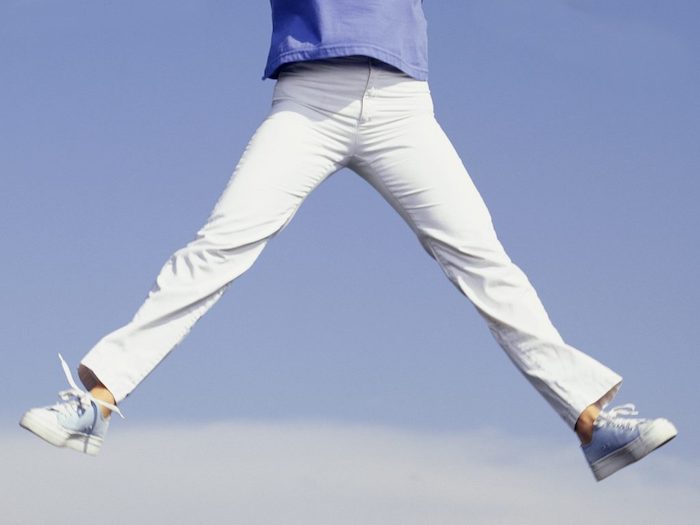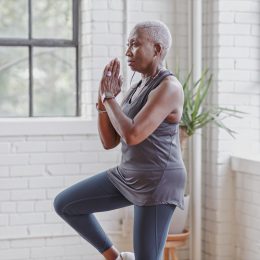4 Jumping Jack Alternatives That Are Easier on Your Knees
Reap all the benefits of this classic exercise without stressing your joints.

If you experience knee pain, the mere sight of jumping jacks can cause your lower body to buckle. But there’s a reason so many workouts still include this classic elementary school exercise: Jumping jacks help strengthen and tone the entire lower body, build ankle and hip stability, and get your heart rate up, says Grayson Wickham, D.P.T., C.S.C.S., a physical therapist and founder of Movement Vault.
But if you haven’t been doing any jumping exercises for the past several years, suddenly adding jumping jacks can cause pain or, worse, injury, says Paul Ochoa, D.P.T., owner of F Squared Physical Therapy in New York City. That’s where modifications come in handy—and eventually pay off.
“When someone does biceps curls, the biceps muscles get stronger and bigger,” Wickman explains. “Jumping jacks similarly work on the leg muscles, joints, and bones.”
In other words, if you do them often enough, your body will adapt by increasing both bone and muscle mass to make your knees stronger. The key is starting with a version of the movement that you can safely and comfortably perform. As always, follow any instructions from your doctor, and listen to your body.
Here are four great options for reaping all the benefits of classic jumping jacks without any of the knee pain. Start by trying only a few reps to make sure you don’t experience any discomfort. If you do, try a different option until you find the right jumping jack alternative for your body. Once you know what works for you, you can swap the movement in whenever a workout calls for jumping jacks.
Get and stay fit with SilverSneakers! Choose from dozens of different Community classes, visit a participating fitness location, or view the current schedule of SilverSneakers LIVE online classes. Check your eligibility here.
1. Front Jacks
Instead of moving side to side, you’ll move forward and backward with front jacks. Moving side to side is harder for your knees because it requires extra stability, Wickham says, so front jacks are a great option for people who feel pain while performing side-to-side movements.
Front jacks are also a great way to get your heart rate up because you can do them at a fast pace, he adds.
Tip: You can adjust the speed or quality of each video by selecting the Settings (gear) icon in the bottom-right corner of the video.
How to do it: Stand tall with your feet together, hands on your hips, and core braced. Simultaneously jump your right foot forward four to six inches in front of you and your left foot four to six inches behind you. Land with a slight bend in both knees, and then jump your feet back to center. From here, repeat on the opposite side to complete one rep. Work up to three sets of six reps.
Make it harder: If you don’t have any shoulder issues, engage your arms. As you jump your feet front and back, move your arms out to the side in an X as you would with a traditional jumping jack. This variation requires coordination because you’ll be moving your arms side to side while moving your legs front and back.
2. Toe-Touch Jacks
This exercise eliminates the jumping but still uses side-to-side movement, allowing you to improve your overall balance and stability without overly stressing your knees, Wickham says.
How to do it: Stand tall with your feet slightly apart. Bring your arms out to the side in an X, or as high as you can comfortably go, while tapping your right foot four to six inches out to the side. Keep your weight in your left leg during the movement.
As you step your right foot back in, lower your arms back down to your sides. Repeat on the opposite side, tapping your left foot out, to complete one rep. If this is the modification for you, aim for two to three sets of eight reps.
Make it harder: Once you’ve mastered tapping four to six inches out to the side, increase the range of motion by stepping farther on each side.
3. Invisible Jump Rope
Little hops are usually easier on wobbly knees than larger side-to-side jumps, Wickham explains. That’s why jumping an invisible rope (or performing bunny hops, if that sounds more fun) is a great alternative to jumping jacks. They’ll get your heart pumping while improving coordination, balance, and muscular development.
How to do it: Stand tall with your feet two to three inches apart—the distance they would be for jumping rope. Place your hands down by your sides. If you prefer, do this move six inches away from a wall, counter, or other sturdy surface, which you can grab onto with one or both hands for support.
Brace your core, and look straight ahead. Slowly bend your knees, and hop about two inches off the floor. Land with both feet, keeping a slight bend in your knees. That’s one rep. Aim for 12 reps total.
Subscribe to our newsletter
It's quick and easy. You could be one of the 13 million people who are eligible.
Already a member? Click to discover our 15,000+ participating locations.
Follow Us
Make it harder: Add a challenge by doing more hops. With this exercise, it’s best to increase reps rather than the intensity of your hops. It will be easier on your bones and joints.
4. Single-Leg Balance
“It may not get your heart rate up as much as traditional jumping jacks, but this exercise is gentler on your knees, shoulders, and upper back,” Wickham explains. Plus, it will help you improve balance, core stability, and glute strength.
How to do it: Stand with your feet together or slightly apart. If you prefer, do this move six inches away from a wall, counter, or other sturdy surface, which you can grab onto with one or both hands for support.
Raise your arms straight out to your sides in a T, or as high as you can comfortably go. As you do this, lift your right leg out to the side about four to six inches off the floor. Make sure your torso stays completely vertical—no leaning to one side.
Pause, then lower your right leg to meet your left and your arms back down to your sides. Repeat on the opposite side to complete one rep. Aim for three sets of six reps.
Make it harder: Once you’ve mastered balancing without holding onto a wall, perform the exercise while holding one- to three-pound dumbbells in each hand. This will challenge your core and glute strength even more.
Check Your SilverSneakers Eligibility Instantly
SilverSneakers members can go to thousands of gyms and fitness locations across the nation, plus take exercise classes designed for seniors and led by supportive instructors. If you have a Medicare Plan, it may include SilverSneakers—at no additional cost. Check your eligibility instantly here.
Already a member? Get your SilverSneakers member ID and exclusive fitness content by logging in to or creating your online account here.





